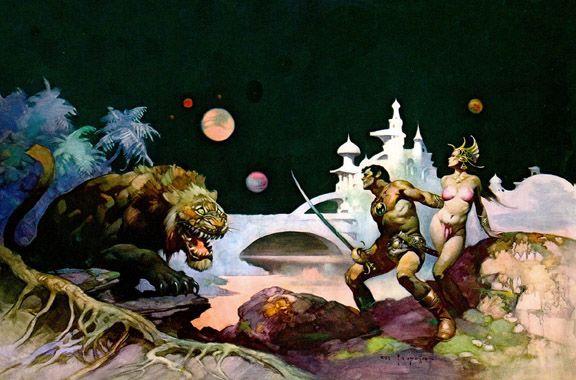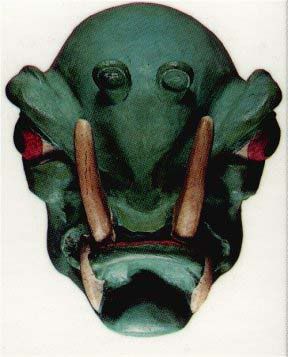What could have been - with some pictures and video to boot
"I Weep Not For What Has Happened, I Weep For What Could Have Been..." Dept.:
Two Animators
Part One - Bob Clampett

John Carter of Barsoom by Frank Frazetta
Clampett had gotten himself a job at the Harman-Ising Studio which was turning out cartoons for Warner Brothers, and he'd been content to learn the craft of animation and to work himself up to a position where he was not only pencil-in-hand animating images for directors like Friz Freling and Tex Avery, but developing gag and story ideas for the short subjects they were working on. Anyone who knew Bob Clampett at any point of his life could tell you that he was ambitious and a very far-thinking man. Since it didn't look like he would be allowed to direct on his own at WB, he decided to devote his spare time to develop a project of his own.
Jim Korkis interviewed Clampett in 1978 and Bob described what was on his mind:
"I had been fascinated with the Burroughs books since I was a youngster, especially the Mars books... An animator can take a pencil and put the city of Rome or a strange planet on a small piece of paper and have a character do anything that comes to his imagination. There is no other medium that allows you to exert such control over every frame of film... Realizing the potential of a fantasy series of cartoons based around Burroughs' characters, I went out to Tarzana to see Burroughs himself and tried to convince him that I could film and sell a series of cartoons based on his JOHN CARTER OF MARS stories..."

Clampett's painting of a Thark
In the series, a world-weary Civil War vet passes out in a cave while escaping some pursuers and has an out of body experience where he believes that he visits the planet Mars but actually arrives on Barsoom, a world populated by weird red skinned humans (who didn't wear a lot of clothing) and 10 foot tall four-armed green tusk-faced Tharks. The women on Barsoom are equals of the men and fight side by side with them. Carter's heavier human physique makes him a superman on Barsoom, and he saves their Princess from court intregue and unites the humans and the Tharks in this wild pirate battle taking place on wooden sail ships that fly.
"Edgar was smart enough to understand that one couldn't just literally translate his Mars books page by page into animation," Clampett said, "it just would not be cinematic. So, he gave me a great deal of freedom to dream up and be inspired by his writing and develop a cartoon story on my own,"

The wooden model of a Thoat - an eight legged Barsoomian riding beast saved by JC Burroughs
Meanwhile Burroughs' son Jack had returned from college and wanted to get involved. He produced maquettes and animation models for Clampett to work with. The two got along like old friends and things were moving along at a good pace. MGM had shown an interest and had the film rights to both the Barsoom books and the Tarzan series - which was already making them a LOT of money after the first three films they'd produced starring Johnny Weismuller and Maureen O'Sullivan.
Things were going along GREAT. Clampett wanted an entirely different look to the film - seperating it from the clowns and singing animals that were all one found in existing animation. Explaining it to Korkis, Clampett said that while he was working nights and weekends on the project, recruiting Burroughs' son and daughter-in-law to help him paint the cels and get things ready,
"We would oil paint the side shadowing frame-by-frame in an attempt to get away from the typical outlining that took place in normal animated films. In the running sequence, for example, there is a subtle blending of figure and line which eliminated the harsh outline. It is more like a human being in tone. We were working in untested territory at that time. There was no animated film to look at to see how it was done," .
Then the MGM money men got cold feet. This would have been 5 years before Walt Disney released SNOW WHITE AND THE SEVEN DWARFS - the feature that proved to Hollywood filmakers that you COULD make an animated film longer than an 8 mins long reel of film that people would pay money to sit through, let alone enjoy. What is more, it was completely different from the kind of light operetta or slapstick one found in the existing cartoons, and that defined what Disney would later do with SNOW WHITE. Essentially telling Head Office what everyone would be telling Disney 3 years later, they felt audiences would not be able to understand nor accept the concept of an Earth man having adventures on Mars. It all just seemed too strange. They pushed for a Burroughs cartoon series featuring Tarzan who was already well-known and well-loved by the public. What is more, because it was a cartoon, the studio went the complete opposite direction to what ERB and Clampett had been going for - funny jungle animals doing silly things and at the end of the cartoon, Tarzan would appear and save these foolish animals from being caught in quicksand or facing a vicious predator. Superman in a fur toga.
Scrapping the project Clampett would later show college students on the lecture circuit in the 1970s the test footage of John Carter running and leaping around the Martian surface, a Thark riding a thoat in full color, Carter involved in a swordfight and other vivid sequences which were quite unlike anything else being done in animation in the 1930s, and in fact, ever. After a quick look online, I've been unable to find the test footage, but I'm told it exists and is proudly featured on the DVD of Clampett's BEANY & CECIL TV series from the 50's.
Had this happened the way it should have, it's unlikely that Disney's SNOW WHITE would have become the template for American animated film that still exists today and dominates our perception of the medium in our culture. Can you imagine a 1950's where Ray Harryhausen was producing live-action fantasy films in EMULATION of the work done 20 years before? Where out-of-the-box classics like what Brad Bird is doing with THE IRON GIANT and THE INCREDIBLES and RATATOUILLE were the norm rather than the exception? What would we be seeing on the screens now?
Cartoon princesses fighting alongside their male counterparts and people bursting into song as an option but not a pre-requisite of being animated on film.
Think of that.